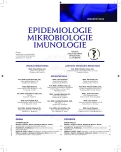Enterovirus sequencing as a new approach to the laboratory diagnosis for clinical and epidemiological purposes
Authors:
P. Rainetová 1; H. Jiřincová 1; M. Musílek 1; Lucie Nováková 1; I. Vodičková 1; V. Štruncová 2; M. Švecová 2; P. Pazdiora 3; N. Piskunová 4; P. Trubač 4; T. Zajíc 3; M. Havlíčková 1
Authors‘ workplace:
Státní zdravotní ústav Praha, Centrum pro epidemiologii a mikrobiologii
1; Fakultní nemocnice, Plzeň, Ústav mikrobiologie, Infekční klinika
2; Lékařská fakulta UK v Plzni, Ústav epidemiologie
3; Krajská nemocnice Liberec a. s., Centrum laboratorní medicíny
4; Nemocnice v Českých Budějovicích, Laboratoř molekulární biologie a genetiky
5
Published in:
Epidemiol. Mikrobiol. Imunol. 64, 2015, č. 2, s. 102-106
Category:
Original Papers
Overview
Objective:
Introducing enterovirus sequencing as an advanced approach to classify the viruses isolated according to the novel nomenclature and to characterize isolates in detail.
Material and methods:
Seventy-five specimens collected from 64 patients in two hospitals, Liberec Regional Hospital, and Plzeň University Hospital, were analyzed. The study patients' age ranged from four to 54 years, with a median of 15 years in males and 16 years in females. In most patients, the reasons for admission were intense headache, fever, vomiting, tiredness, meningeal symptoms, intestinal symptoms (in two patients), and skin symptoms (in one patient). The speci-mens collected were rectal and throat swabs, cerebrospinal fluid (CSF) and stool specimens. Molecular detection and typing were performed using the RT-PCR method. A segment of the 5´non-coding RNA was selected for typing. Specimens were amplified using single-step PCR with external primers and with the same primers extended to include M13 sequen-ces (Generi-Biotech). The LASERGENE software (DIASTAR) was used in sequence editing, alignment, and quality check. The sequences obtained were checked against the central GenBank sequence database using the BLAST algorithm.
Results:
The identification of the study isolates resulted in 61 ECHO viruses 30, three coxsackie viruses B1, one coxsackie virus B3, one coxsackie virus A9, one enterovirus 86, one enterovirus 71, Two ECHO viruses 13/coxsackie virus B5, one ECHO virus 7/30/coxsackie virus B4, one coxsackie virus B4/enterovirus B, one enterovirus 87/ECHO virus 30/enterovirus B, and one ECHO virus 3. All viruses isolated, except enterovirus 71 classified into group A, were of group B.
Conclusion:
The enteroviruses were identified unambigously, although the sequencing only targeted a short, conserved segment that showed considerable variability. The sequencing was an effective alternative to enterovirus identification by the neutralisation test and allowed for detailed characterization of the isolates. The predominance of ECHO 30 as the cause of aseptic meningitis is in accordance with the literature data.
Keywords:
sequencing – enteroviruses – aseptic meningitis
Sources
1. Takami T, Kawashima H, Takei Y, et al. Usefulness of nested PCR and sequence analysis in a nosocomial outbreak of neonatal enterovirus infection. J Clin Virol, 1998;11(1):67–75.
2. Votava M, Obdržálek V, Ondrovčík P, et al. Lékařská mikrobiologie II. Přehled vyšetřovacích metod v lékařské mikrobiologii. Brno: Masarykova univerzita. Lékařská fakulta;2000.
3. Oberste MS, Maher K, Kilpatrick DR, et al. Typing of human enteroviruses by partial sequencing of VP1. J Clin Microbiol, 1999;37(5):1288–1293.
4. Milia MG, Cerutti F, Gregori G, et al. Recent outbreak of aseptic menin-gitis in Italy due Echovirus 30 and phylogenetic relationship with other European circulating strains. J Clin Virol, 2013 : 58(3):579–583.
5. Polio laboratory manual. 4th ed. Geneva: World Health Organization, 2004.
6. Oberste MS, Maher K, Kilpatrick DR, et al. Molecular evolution of the human enteroviruses: correlation of serotype with VP1 sequence and application to picornavirus classification. J Virol, 1999;73(3):1941–1948.
7. Kubo H, Iritani N, Seto Y. Molecular classification of Enteroviruses not identified by neutralization tests. Emerg Infect Dis, 2002;8(3):298–304.
8. Logotheti M1, Pogka V, Horefti E, et al. Laboratory investigation and phylogenetic analysis of enteroviruses involved in an aseptic menin-gitis outbreak in Greece during the summer of 2007. J Clin Virol, 2009;46(3):270–274.
9. Xiao H, Guan D, Chen R, et al. Molecular characterization of echovirus 30-associated outbreak of aseptic meningitis in Guangdong in 2012. Virol J, 2013;10 : 263–267.
10. Castro, CMO de, OliveiraI DS, MacedoI O, et al. Echovirus 30 associated with cases of aseptic meningitis in state of Pará, Northern Brazil. Mem Inst Oswaldo Cruz, 2009;104(3):444–450.
11. Tkadlecová H. Výskyt enterovirových meningitid v kolektivu. In: 24. Pečenkovy epidemiologické dny: 15.–17. 9. 2010, České Budějovice. Jihlava: Zdeněk Hajn;2010 : 43. ISBN 978-80-904667-0-8.
Labels
Hygiene and epidemiology Medical virology Clinical microbiologyArticle was published in
Epidemiology, Microbiology, Immunology

2015 Issue 2
Most read in this issue
- The possibilities of zoonotic transmission of rotaviruses
- Hepatitis E – overview of the latest knowledge
- The prevalence of nasal carriage of Staphylococcus aureus aureus and methicillin-resistant S. aureus (MRSA) among general medicine students of the Palacky University Olomouc
- Toxoplasmosis in immunocompromised patients
